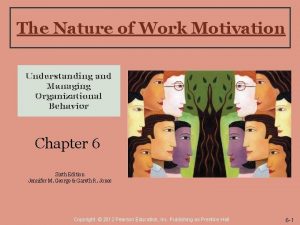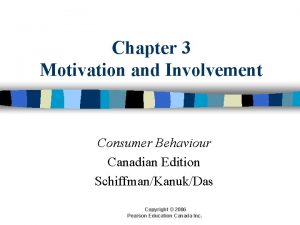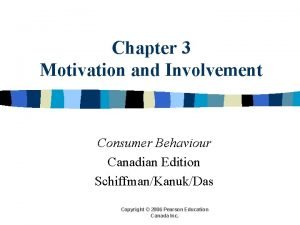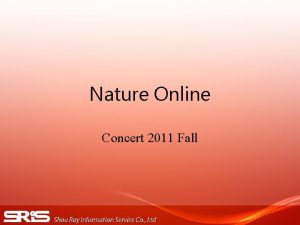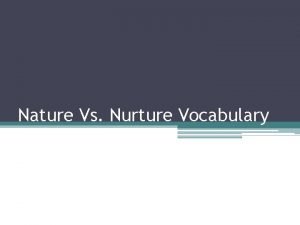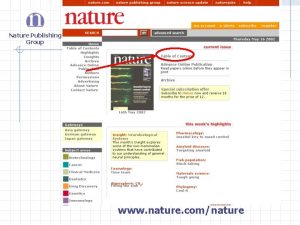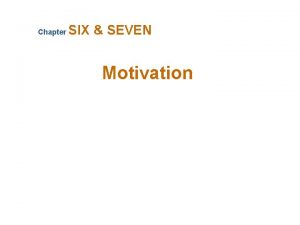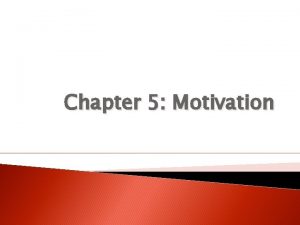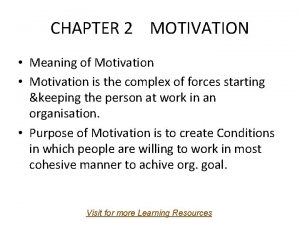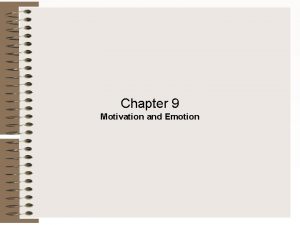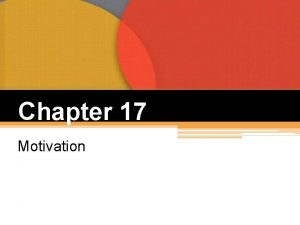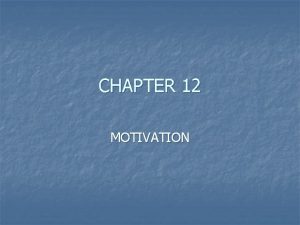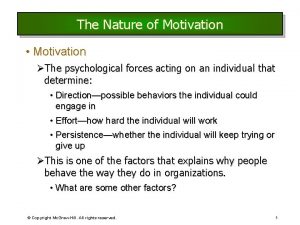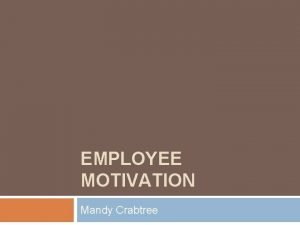CHAPTER 4 MOTIVATION The Nature of Motivation Motivation










































- Slides: 42

CHAPTER 4 MOTIVATION

The Nature of Motivation • Motivation is a complex phenomenon – Motives can’t be observed; only inferred from behavior of others – Some motives remain active even when original goal is attained

Achievement Motivation Theory • Thematic Apperception Test • The Mc. Clelland Studies

The Thematic Apperception Test • Created by Henry Murray to uncover people’s dominant needs • Establishes the presence and strength of various needs • Respondents are shown a series of pictures and asked to create stories • Murray found people’s stories reflect their dominant needs

The Mc. Clelland Studies • Used story telling to study dominant needs focusing only on a limited set of needs: – The need for Achievement – The need for Affiliation – The need for Power

The Mc. Clelland Studies (cont. ) • Most well known for findings in area of Achievement: – Associated with high performance levels and executive success – People with dominant achievement take risks, personal responsibility, and desire specific feedback

The Mc. Clelland Studies (cont. ) – Such individuals are motivated by performance based satisfaction than by money – Need for achievement is not appropriate for every job – Origin of achievement motivation lies in one’s socialization during childhood

The Mc. Clelland Studies (cont. ) • People with high need for affiliation are warm and friendly in relationships • May be seen as relatively ineffective unless their high affiliation needs are balanced by a high need for achievement and power

The Mc. Clelland Studies (cont. ) • May be perceived as fearful of confrontation in their interpersonal relations • Mc. Clelland suggests that economic growth is always preceded by a growth in the economy

The Mc. Clelland Studies (cont. ) • Mc. Clelland also suggests that achievement motivation can be taught – Those selected already possess a proclivity toward achievement, due to their entrepreneurial predisposition

Maslow’s Hierarchy of Needs • Abraham Maslow developed a model that explained essential needs for healthy psychological development • Needs tend to be hierarchical, with lower ones associated with essential survival, and with levels increasing in terms of potency

Maslow’s Hierarchy of Needs (cont. ) • Deficiency needs: Must be satisfied to ensure existence and security; (lower order needs) include physiological, safety, social needs • Growth needs: Concerned with personal development and realization of one’s potential; (high order needs) includes esteem and self-actualization

Complete Hierarchy • Physiological needs: Food, water, sleep, oxygen, warmth, freedom from pain; most basic level • Safety needs: Relate to obtaining a secure environment in which an individual is free from threats; e. g. job tenure, savings accounts, insurance policies

Complete Hierarchy (cont. ) • Social needs: Needs for affection, love, sexual expression • Esteem needs: Concern for self-respect and esteem of others • Self-actualization needs: Desire for fulfillment in terms of parenting, athletics, artistic success, occupational success

Maslow’s Hierarchy of Needs (cont. ) • Prepotency: May occur if a lower level need regains dominance • Needs typically emerge gradually, and are partially satisfied

Criticisms of Maslow’s Work • Center on the basis of his work with neurotic patients • The fact that the hierarchy he proposes may not be consistent for all individuals • Mihaly Cskikszentmihalyi’s proposed the notion of flow

Herzberg’s Two Factor Theory • Based on interviews with 203 engineers and accountants • Individuals were asked to reveal two separate job-related events in which their work satisfaction had improved or declined

Herzberg’s Two Factor Theory (cont. ) • Findings suggested that there were two completely separate sets of factors, one leads to feelings of satisfaction, the other leads to dissatisfaction • Motivator Factors: Pertained to the content of the job; e. g. career advancement, recognition, achievement, sense of responsibility

Herzberg’s Two Factor Theory (cont. ) • Hygiene Factors: Stemmed from the context in which the job was performed, e. g. job security, company policies, interpersonal relations, working conditions

Herzberg’s Two Factor Theory (cont. ) • When present, motivator factors said to lead directly to employees’ feelings of satisfaction, while when not present, they were said to lead to feelings of “no satisfaction” or a neutral state

Herzberg’s Two Factor Theory (cont. ) • When not present, hygiene factors lead to dissatisfaction of employees, while even if present they were said to be incapable of motivating workers to feel satisfied in their jobs

Herzberg’s Two Factor Theory (cont. ) • A criticism concerns categories themselves; some view salary as a sense of pride, to some it is a motivator and others it is a hygiene factor

Expectancy Theory • Explains workers motivation in terms of anticipated rewards • Vroom argues that the psychological force on an employee to exert effort is a function of two factors: – Expectancies in future – Attractiveness of specific outcomes

Expectancy Theory (cont. ) Expectancies can be viewed on two levels: • Effort ® Performance • Performance ® Outcome

Expectancy Theory (cont. ) • Outcomes are evaluated in terms of their attractiveness to employees, or their valence • Motivation can be quantitatively expressed in this theory by assigning personal probability to each type of employee expectation

Expectancy Theory (cont. ) Motivation can be expressed as: (E®P) x (P®O) x (V) = Motivational Force

Implications of Expectancy Theory • Employees should recognize that effort and performance are closely related • Manager’s job includes the establishment of conditions that help translate effort into performance • Managers need to create linkages between rewards and performance

Reinforcement Theory • Behavior Modification increases in success if the following criteria are met: – Rewards offered are substantial and desired – Rewards are administered intermittently – Rewards are distributed so that higher levels of performance lead to proportionally larger increases in rewards

Comparison and Contrast • Comparison of expectancy and reinforcement theory: both theories share a hedonistic base • Contrasts of these theories reveal: – Expectancy theory can be viewed as hedonism of the future, it focuses on the influence of anticipated rewards on present behavior

Comparison and Contrast (cont. ) – Reinforcement theory can be viewed as hedonism of the past, it focuses on the influence of past rewards in shaping present behavior

Equity Theory • Assumes that people will strive to restore equity if they feel an imbalance exists • Based on core assumption that people continuously monitor the degree of equity or inequity that exists in their working relations by comparing their own outcomes and inputs against others’ ratios

Equity Theory (cont. ) • Outcomes: Anything provided by an employee’s job; e. g. pay, window in office, use of company car • Inputs: All contributions that a person makes to the employment relationship; e. g. personal effort, years and type of education, prior experience, training

Equity Theory (cont. ) • Comparison other: The person in the work setting to which an individual compares his/her behavior • Inequity: When a person feels that his/her outcomes/inputs ratio is either higher or lower than comparison others

Equity Theory (cont. ) • Higher ratio status: The individual will likely decrease the quantity of their output and increase the quality of their output relative to more equitably paid workers

Equity Theory (cont. ) • Lower ratio status: If the employee feels undercompensated in terms of outcomes, then they have a variety of options to pursue based on the psychological tension that results from the inequity

Equity Theory (cont. ) • Attempt to restore equity by working on 1 of the 4 components in the 2 ratios: – Increase outcomes by asking for raise – Decrease inputs by being less productive – Decrease comparison to someone else’s outcomes by persuading boss to alter B’s pay – Increase B’s inputs by pressuring him/her to work harder

Equity Theory (cont. ) • If inequality can’t be rectified, then the individual may choose to pursue any of the following options: – Alter perceptions of situation to make inequity disappear – Select a different comparison other – Leave the work setting by getting a new job

Social Learning • Incorporates the notion that people imitate models • Contends that people develop expectancies about their capacity to behave in certain ways, and the probability that the behavior will result in rewards

Social Learning (cont. ) • Self-administration of rewards is an important part of social learning theory • Use of social learning theory principles in conjunction with extrinsic rewards for performance may provide a most effective combination of motivational approaches

Porter-Lawler’s Model of Motivation • Integrates both content and process theories into one interactive model • Content theories: discuss what motivates people to perform; e. g. theories of Maslow, Herzberg, and Mc. Clelland • Process theories: discuss how rewards control behavior; e. g. expectancy, equity, reinforcement, social learning theories

Conclusions of Porter-Lawler’s Model • A checklist for managers to use in motivating employees. Managers should: – Offer valued rewards – Create perceptions that effort will lead to rewards – Design jobs so that effort leads to high performance – Hire qualified employees

Conclusions of Porter-Lawler’s Model (cont. ) – Train employees in the correct manner for performing their task – Design tasks so that performance is measurable – Design reward systems so that rewards are tied to performance – Ensure that rewards are viewed as fair and equitable
 Nature and nature's laws lay hid in night meaning
Nature and nature's laws lay hid in night meaning Determinace lidské psychiky
Determinace lidské psychiky Nature of work motivation
Nature of work motivation Dynamic nature of motivation in consumer behaviour
Dynamic nature of motivation in consumer behaviour Consumer behaviour motivation
Consumer behaviour motivation Hát kết hợp bộ gõ cơ thể
Hát kết hợp bộ gõ cơ thể Lp html
Lp html Bổ thể
Bổ thể Tỉ lệ cơ thể trẻ em
Tỉ lệ cơ thể trẻ em Gấu đi như thế nào
Gấu đi như thế nào Thang điểm glasgow
Thang điểm glasgow Hát lên người ơi
Hát lên người ơi Môn thể thao bắt đầu bằng từ chạy
Môn thể thao bắt đầu bằng từ chạy Thế nào là hệ số cao nhất
Thế nào là hệ số cao nhất Các châu lục và đại dương trên thế giới
Các châu lục và đại dương trên thế giới Công thức tính độ biến thiên đông lượng
Công thức tính độ biến thiên đông lượng Trời xanh đây là của chúng ta thể thơ
Trời xanh đây là của chúng ta thể thơ Mật thư anh em như thể tay chân
Mật thư anh em như thể tay chân Làm thế nào để 102-1=99
Làm thế nào để 102-1=99 Phản ứng thế ankan
Phản ứng thế ankan Các châu lục và đại dương trên thế giới
Các châu lục và đại dương trên thế giới Thơ thất ngôn tứ tuyệt đường luật
Thơ thất ngôn tứ tuyệt đường luật Quá trình desamine hóa có thể tạo ra
Quá trình desamine hóa có thể tạo ra Một số thể thơ truyền thống
Một số thể thơ truyền thống Bàn tay mà dây bẩn
Bàn tay mà dây bẩn Vẽ hình chiếu vuông góc của vật thể sau
Vẽ hình chiếu vuông góc của vật thể sau Thế nào là sự mỏi cơ
Thế nào là sự mỏi cơ đặc điểm cơ thể của người tối cổ
đặc điểm cơ thể của người tối cổ V cc cc
V cc cc Vẽ hình chiếu đứng bằng cạnh của vật thể
Vẽ hình chiếu đứng bằng cạnh của vật thể Tia chieu sa te
Tia chieu sa te Thẻ vin
Thẻ vin đại từ thay thế
đại từ thay thế điện thế nghỉ
điện thế nghỉ Tư thế ngồi viết
Tư thế ngồi viết Diễn thế sinh thái là
Diễn thế sinh thái là Các loại đột biến cấu trúc nhiễm sắc thể
Các loại đột biến cấu trúc nhiễm sắc thể Số.nguyên tố
Số.nguyên tố Tư thế ngồi viết
Tư thế ngồi viết Lời thề hippocrates
Lời thề hippocrates Thiếu nhi thế giới liên hoan
Thiếu nhi thế giới liên hoan ưu thế lai là gì
ưu thế lai là gì Sự nuôi và dạy con của hươu
Sự nuôi và dạy con của hươu


